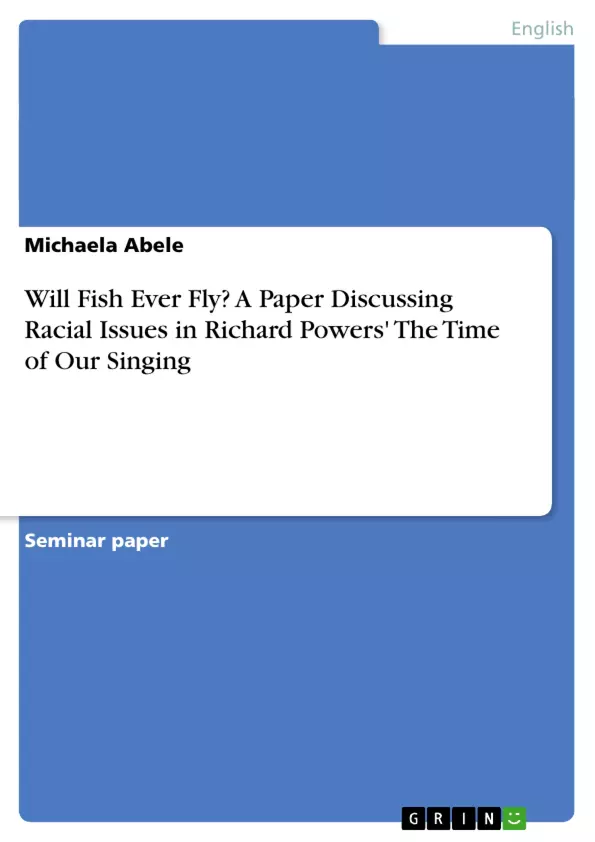“The bird and the fish can fall in love.” A catchy saying, that suggests the possibility of a highly unconventional pairing. Nevertheless, it immediately evokes a non-trivial question: “But where will they build their nest?” Paradoxically, the saying starts off conveying hope for bird and fish’s unequal relationship, yet its continuation instantly deprives it of all its initial confidence again, leaving behind only a dull prospect of this couple’s common future. It seems as if there is only little chance for the two to set up a family - though it is not said to be impossible. However, even if bird and fish eventually managed to find an apt nesting place, how would their story go on? Would they be able to live together? Could they survive at the periphery of their habitats? Apart from those questions dealing with the couple itself, some of the most interesting questions arising would certainly concentrate on their progeny, and in how far they would combine parental features - or differ from fish and bird respectively. Would either of their parental lines dominate the other? And if so, which aspects of life would this dominance affect? Would it go as far as to predict which habitat fish and bird’s progeny would occupy at last?
In his latest novel, The Time of Our Singing, Richard Powers applies this saying to the situation of interracial marriages and their mixed-race offspring in the twentieth century US society. He portrays a black-and-white couple’s ambitions to overcome the enormous obstacles associated with realizing the seemingly impossible: setting up a mixed-race family and raising their children “beyond race” (Powers 424). Yet despite all their efforts and sacrifices, the couple’s endeavors fail; this actually is mirrored not only by their own lives, but also by the lives of their hybrid children, neither of whom makes it “beyond race” in the end. However, is this meant to imply that racial boundaries are so powerful that they cannot be overcome? Is it as unlikely to find a way interfacing black and white as it is suggested by the desperate situation of fish and bird?
Inhaltsverzeichnis (Table of Contents)
- The Problem of Race
- Race and Identity
- Phenotypic Features
- The One-Drop Rule
- Genomics
- Culture
Zielsetzung und Themenschwerpunkte (Objectives and Key Themes)
This paper delves into the complexities of race and racial identity in Richard Powers' novel, The Time of Our Singing. It explores the challenges faced by a mixed-race family in the twentieth-century US, examining how societal perceptions and boundaries impact their lives.
- The multifaceted nature of race and its elusive definition.
- The societal and cultural constraints surrounding interracial relationships and mixed-race identities.
- The impact of racial categorization on individual experiences and opportunities.
- The enduring power of racial boundaries and the difficulty of transcending them.
- The intersection of race with other social constructs, such as gender and culture.
Zusammenfassung der Kapitel (Chapter Summaries)
The paper begins by defining the term "race" and exploring its various interpretations, highlighting the multifaceted and often ambiguous nature of racial categorization. It then examines different criteria proposed to determine one's blackness, such as physical features, the one-drop rule, and genetic markers. Each approach is critically analyzed and found to be insufficient in providing a definitive and universally applicable measure of racial identity.
The paper further examines the cultural dimension of race, arguing that cultural preferences alone cannot adequately determine racial affiliation. It uses the example of Delia, a black woman who excels in classical music, yet is denied entry to a conservatory due to her race. The paper concludes that race is not a simple concept defined by a single factor, but a complex and multifaceted phenomenon shaped by multiple intersecting influences.
Schlüsselwörter (Keywords)
This paper focuses on the key concepts of race, racial identity, interracial relationships, mixed-race families, and societal perceptions of race. It draws on theories and ideas from prominent scholars in the fields of race studies, gender studies, and cultural studies to explore the challenges and complexities surrounding racial categorization and its impact on individual lives.
- Quote paper
- Michaela Abele (Author), 2005, Will Fish Ever Fly? A Paper Discussing Racial Issues in Richard Powers' The Time of Our Singing, Munich, GRIN Verlag, https://www.grin.com/document/47276



